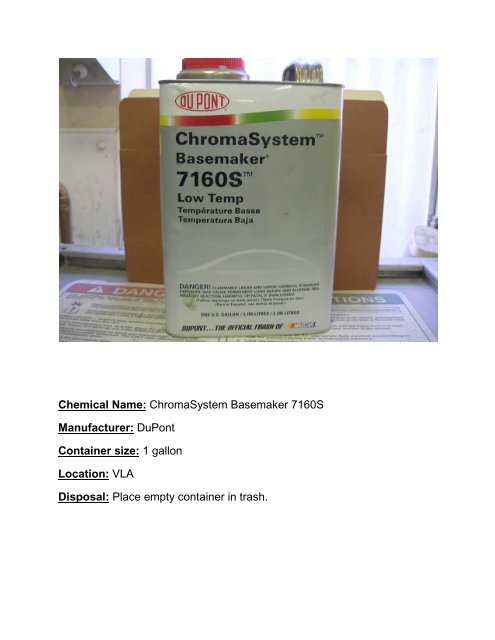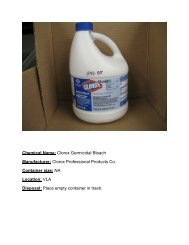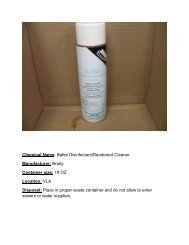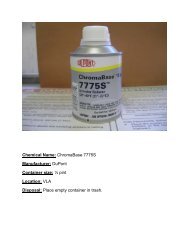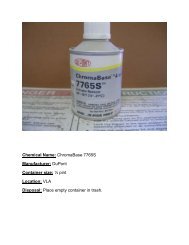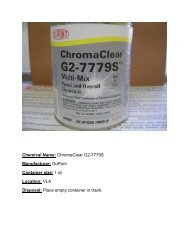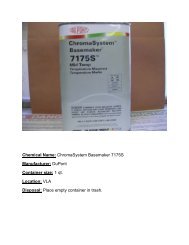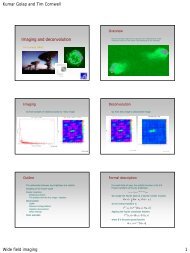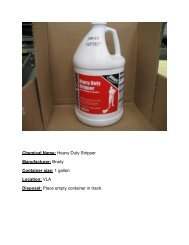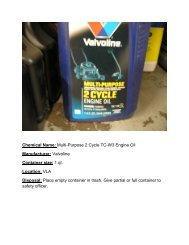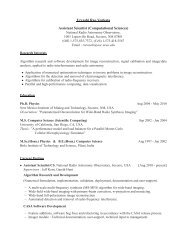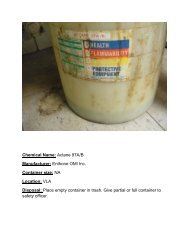Du Pont ChromaSystem Basemaker 7160S
Du Pont ChromaSystem Basemaker 7160S
Du Pont ChromaSystem Basemaker 7160S
You also want an ePaper? Increase the reach of your titles
YUMPU automatically turns print PDFs into web optimized ePapers that Google loves.
Chemical Name: <strong>ChromaSystem</strong> <strong>Basemaker</strong> <strong>7160S</strong><br />
Manufacturer: <strong>Du</strong><strong>Pont</strong><br />
Container size: 1 gallon<br />
Location: VLA<br />
Disposal: Place empty container in trash.
MSDS 12<br />
Isocyanate Activators, Hardeners,<br />
and Additives<br />
1. Identification of the substance/mixture and of the company/undertaking<br />
Manufacturer: E. I. du <strong>Pont</strong> de Nemours and Company.<br />
<strong>Du</strong><strong>Pont</strong> Performance Coatings<br />
Wilmington, DE 19898<br />
Telephone: Product information: (800) 441-7515<br />
Medical emergency: (800) 441-3637<br />
Transportation emergency: (800) 424-9300 (CHEMTREC)<br />
Product: Isocyanate Activators, Hardeners, and Additives<br />
DOT Shipping Name: See DOT Addendum.<br />
Hazardous Materials Information: See Section 10.<br />
<strong>Du</strong><strong>Pont</strong> Performance Coatings<br />
Material Safety Data Sheet<br />
Copyright 2010 E. I. du <strong>Pont</strong> de Nemours and Company. All rights reserved. Copies may be made only for those using du <strong>Pont</strong> products.<br />
2. Composition/information on ingredients<br />
INGREDIENTS<br />
1,2,4-trimethyl benzene<br />
CAS #<br />
95-63-6<br />
VAPOR<br />
PRESSURE<br />
7.0@44.4<br />
EXPOSURE LIMITS<br />
◦ C A 25.0 ppm, O 25.0 ppm<br />
1,6-hexamethylene diisocyanate 822-06-0 0.0@25.0 ◦ C A 5.0 ppb, O None<br />
2,4,6- tri((dimethylamino)methyl) phenol 90-72-2 0.0@21.0 ◦ C A None, O None<br />
2-ethylhexyl acetate 103-09-3 0.5 A None, O None<br />
2-methyl butyl acetate 624-41-9 None A 100.0 ppm 15 min STEL, A 50.0 ppm, O None<br />
4,6-dimethyl-2-heptanone 19549-80-5 None A None, O None<br />
4-chlorobenzotrifluoride 98-56-6 7.6@25.0 ◦ C D 20.0 ppm 8 & 12 hour TWA, A None, O None<br />
Acetone 67-64-1 247.0@68.0 ◦ F A 750.0 ppm 15 min STEL, A 500.0 ppm, O 1000.0 ppm,<br />
D 500.0 ppm 8 & 12 hour TWA<br />
Aliphatic polyisocyanate resin 28182-81-2 None S 0.5 mg/m3, A None, O None<br />
Aromatic hydrocarbon-A 64742-94-5 10.0 D 100.0 ppm, A None, O None<br />
Aromatic hydrocarbon-B 64742-95-6 10.0@25.0 ◦ C D 50.0 ppm, A None, O None<br />
Bis(1,2,2,6,6-pentamethyl-4-piperidinyl)<br />
sebacate<br />
41556-26-7 None A None, O None<br />
Butyl acetate 123-86-4 10.0 A 200.0 ppm 15 min STEL, A 150.0 ppm, O 150.0 ppm<br />
Cumene 98-82-8 3.7 A 50.0 ppm, O 50.0 ppm Skin<br />
Dibutyl tin dilaurate 77-58-7
MSDS 12<br />
Isocyanate Activators, Hardeners,<br />
and Additives<br />
<strong>Du</strong><strong>Pont</strong> Performance Coatings<br />
Material Safety Data Sheet<br />
INGREDIENTS<br />
Toluene<br />
CAS #<br />
108-88-3<br />
VAPOR<br />
PRESSURE<br />
22.0<br />
EXPOSURE LIMITS<br />
A 20.0 ppm , O 300.0 ppm CEIL, O 500.0 ppm 10 min<br />
TWA, O 200.0 ppm, D 50.0 ppm 8 & 12 hour TWA Skin<br />
Trixylenyl phosphate 25155-23-1 1.0 A None, O None<br />
Vm&p naphtha 8032-32-4 17.9@68.0 ◦ F A 300.0 ppm, D 100.0 ppm, O None<br />
Xylene 1330-20-7 8.0@25.0 ◦ C A 150.0 ppm 15 min STEL, A 100.0 ppm, O 100.0 ppm,<br />
D 150.0 ppm 15 min STEL, D 100.0 ppm 8 & 12 hour<br />
TWA<br />
October 1, 2010<br />
Page: 2<br />
*A=ACGIH, O=OSHA, D=<strong>Du</strong><strong>Pont</strong>, S=Suppliers. Limits are 8 hour TWA unless otherwise specified. Vapor pressure @ 20 ◦ C unless otherwise noted.<br />
3. Hazards identification<br />
Potential Health Effects:<br />
Inhalation:<br />
May cause nose and throat irritation. May cause nervous system depression, characterized by the following progressive steps: headache, dizziness, nausea, staggering<br />
gait, confusion, unconsciousness. Reports have associated repeated and prolonged overexposure to solvents with permanent brain and nervous system damage. If this<br />
product contains or is mixed with an isocyanate activator/hardener, the following health effects may apply: Exposure to isocyanates may cause respiratory sensitization.<br />
This effect may be permanent. Symptoms include an asthma-like reaction with shortness of breath, wheezing, cough or permanent lung sensitization. This effect may be<br />
delayed for several hours after exposure. Repeated overexposure to isocyanates may cause a decrease in lung function, which may be permanent. Individuals with lung<br />
or breathing problems or prior reactions to isocyanates must not be exposed to vapors or spray mist of this product.<br />
Ingestion:<br />
May result in gastrointestinal distress.<br />
Skin or eye contact:<br />
May cause irritation or burning of the eyes. Repeated or prolonged liquid contact may cause skin irritation with discomfort and dermatitis.<br />
Other Potential Health Effects in addition to those listed above:<br />
4-chlorobenzotrifluoride<br />
Increased susceptibility to the effects of this material may be observed in people with preexisting disease of any of the following: skin. Prolonged or repeated exposure<br />
may cause damage to any of the following organs/systems: kidneys, liver, thyroid. Potential skin sensitizer that may cause allergic reactions and contact dermatitis<br />
resulting in severe irritation, dryness, and cracking of the skin. Ingestion may cause any of the following: gastrointestinal irritation. Eye contact may cause any of the<br />
following: permanent eye injury. Inhalation may cause any of the following: stupor (central nervous system depression), respiratory tract irritation.<br />
Acetone<br />
The following medical conditions may be aggravated by exposure: lung disease, eye disorders, skin disorders. Overexposure may cause damage to any of the following<br />
organs/systems: blood, central nervous system, eyes, kidneys, liver, respiratory system, skin.<br />
Aliphatic polyisocyanate resin<br />
Overexposure may cause asthma-like reactions with shortness of breath, wheezing, cough, which may be permanent; or permanent lung sensitization. This effect may<br />
be delayed for several hours after exposure. The following medical conditions may be aggravated by exposure: asthma, skin disorders, respiratory disorders. Potential<br />
skin sensitizer that may cause allergic reactions and contact dermatitis resulting in severe irritation, dryness, and cracking of the skin. Skin or eye contact may cause any<br />
of the following: irritation.<br />
Aromatic hydrocarbon-A<br />
Laboratory studies with rats have shown that petroleum distillates can cause kidney damage and kidney or liver tumors. These effects were not seen in similar studies<br />
with guinea pigs, dogs, or monkeys. Several studies evaluating petroleum workers have not shown a significant increase of kidney damage or an increase in kidney or<br />
liver tumors.<br />
Aromatic hydrocarbon-B<br />
The following medical conditions may be aggravated by exposure: skin disorders. Laboratory studies with rats have shown that petroleum distillates can cause kidney<br />
damage and kidney or liver tumors. These effects were not seen in similar studies with guinea pigs, dogs, or monkeys. Several studies evaluating petroleum workers<br />
have not shown a significant increase of kidney damage or an increase in kidney or liver tumors.<br />
Bis(1,2,2,6,6-pentamethyl-4-piperidinyl) sebacate<br />
Repeated exposure may cause allergic skin rash, itching, swelling.<br />
Butyl acetate<br />
May cause abnormal liver function. The following medical conditions may be aggravated by exposure: respiratory system. Tests for embryotoxic activity in animals has<br />
been inconclusive. Rats exposed to very high airborne levels have exhibited high frequency hearing deficits. The significance of this to man is unknown. Has been toxic<br />
to the fetus in laboratory animals at doses that are toxic to the mother.<br />
Cumene<br />
WARNING: This chemical is known to the State of California to cause cancer.<br />
Diisobutyl ketone<br />
The following medical conditions may be aggravated by exposure: asthma, blood, dermatitis. Contact may cause skin irritation with discomfort or rash. Repeated<br />
exposure may cause allergic skin rash, itching, swelling. This substance may cause damage to any of the following organs/systems: eyes, kidneys, liver. Extremely high<br />
oral and inhalation doses in laboratory animals have shown weight changes in various organs such as the liver, kidney, brain, heart and adrenal gland. In addition liver<br />
and kidney injury were observed at the extremely high inhalation level. In another inhalation study there was a slight depression in the white blood cell count. Liquid or<br />
vapor causes irritation, experienced as stinging, excess blinking and tear production, with excess redness and swelling of the conjuctiva.<br />
Ethanol, 2-(2-butoxyethoxy)-<br />
Increased susceptibility to the effects of this material may be observed in people with preexisting disease of any of the following: central nervous system, eyes, kidneys,<br />
liver, skin. Tests in laboratory animals have shown effects on any of the following organs/systems: blood, kidneys, liver. Recurrent overexposure may result in liver and<br />
kidney injury. High doses in laboratory animals have shown non specific effects such as irritation, weight loss, moderate blood changes. Eye contact may cause any of<br />
the following: severe irritation, burns, corneal injury.
MSDS 12<br />
Isocyanate Activators, Hardeners,<br />
and Additives<br />
<strong>Du</strong><strong>Pont</strong> Performance Coatings<br />
Material Safety Data Sheet<br />
October 1, 2010<br />
Page: 3<br />
Ethyl acetate<br />
Increased susceptibility to the effects of this material may be observed in people with preexisting disease of any of the following: eyes, respiratory system, skin. Tests in<br />
laboratory animals have shown effects on any of the following organs/systems: blood, kidneys, liver.<br />
Ethylbenzene<br />
Is an IARC, NTP or OSHA carcinogen. Increased susceptibility to the effects of this material may be observed in people with preexisting disease of any of the following:<br />
central nervous system, kidneys, liver, lungs. Recurrent overexposure may result in liver and kidney injury. Studies in laboratory animals have shown reproductive,<br />
embryotoxic and developmental effects. WARNING: This chemical is known to the State of California to cause cancer.<br />
Ethylene glycol monobutyl ether acetate<br />
May destroy red blood cells. May cause abnormal kidney function. May cause temporary upper respiratory and/or lung irritation with cough, difficult breathing, or<br />
shortness of breath. The following medical conditions may be aggravated by exposure: central nervous system, gastrointestinal system, kidneys, liver, dermatitis. Can be<br />
absorbed through the skin in harmful amounts. Overexposure may cause damage to any of the following organs/systems: blood, kidneys, liver. Ingestion may cause<br />
headache, nausea, vomiting, dizziness, and drowsiness.<br />
Heptane<br />
Increased susceptibility to the effects of this material may be observed in people with preexisting disease of any of the following: central nervous system, respiratory<br />
system, skin. May cause central nervous system effects such as dizziness, headache, nausea, and loss of consciousness. Laboratory studies with rats have shown that<br />
petroleum distillates can cause kidney damage and kidney or liver tumors. These effects were not seen in similar studies with guinea pigs, dogs, or monkeys. Several<br />
studies evaluating petroleum workers have not shown a significant increase of kidney damage or an increase in kidney or liver tumors. Aspiration may occur during<br />
swallowing or vomiting, resulting in lung damage.<br />
Isobutyl alcohol<br />
Has shown carcinogenic activity in laboratory animals at high doses. Significance to man is unknown. May cause irritation of the mucous membranes. May cause<br />
abnormal liver function. Increased susceptibility to the effects of this material may be observed in people with preexisting disease of any of the following: eyes, respiratory<br />
system, skin. Tests in laboratory animals have shown effects on any of the following organs/systems: bone marrow, liver. Prolonged skin contact may cause chemical<br />
burns. Liquid splashes in the eye may result in chemical burns.<br />
Isophorone diisocyanate<br />
Overexposure may cause damage to any of the following organs/systems: lungs, skin. The following medical conditions may be aggravated by overexposure: asthma,<br />
eczema, skin disorders, respiratory disorders.<br />
Isophorone diisocyanate homopolymer<br />
May cause temporary upper respiratory and/or lung irritation with cough, difficult breathing, or shortness of breath. Overexposure may cause asthma-like reactions with<br />
shortness of breath, wheezing, cough, which may be permanent; or permanent lung sensitization. This effect may be delayed for several hours after exposure. Repeated<br />
and prolonged overexposure may cause delayed effects involving the respiratory system. Repeated overexposure to isocyanates may cause lung injury, including a<br />
decrease in lung function, which may be permanent. Overexposure may cause damage to any of the following organs/systems: lungs, skin. The following medical<br />
conditions may be aggravated by overexposure: asthma, eye disorders, eczema, skin disorders, respiratory disorders.<br />
Isopropyl alcohol<br />
The following medical conditions may be aggravated by exposure: dermatitis, respiratory disease. Developmental toxicity was seen in rat’s offspring at doses that were<br />
maternally toxic. Contact will cause moderate to severe redness and swelling, itching, tingling sensation, painful burning. May cause injury to the cornea of the eyes.<br />
Prolonged or repeated exposure may cause damage to any of the following organs/systems: liver. Ingestion studies on laboratory animals showed that very high oral<br />
doses caused increased liver and kidney weights.<br />
Methyl ethyl ketone<br />
Material is irritating to mucous membranes and upper respiratory tract. Increased susceptibility to the effects of this material may be observed in people with preexisting<br />
disease of any of the following: central nervous system, eyes, respiratory system, skin. Prolonged or repeated overexposure may cause any of the following:<br />
conjunctivitis, dermatitis. High concentrations have caused embryotoxic effects in laboratory animals. Aspiration may occur during swallowing or vomiting, resulting in<br />
lung damage. Ingestion may cause headache, nausea, vomiting, dizziness, and drowsiness.<br />
N-beta-(aminoethyl)-gamma-aminopropyltrimethoxysilane<br />
May cause allergic skin reaction. Can produce skin sensitization in animals.<br />
Naphthalene<br />
Is an IARC, NTP or OSHA carcinogen. Tests in some laboratory animals demonstrate carcinogenic activity. Increased susceptibility to the effects of this material may be<br />
observed in people with preexisting disease of any of the following: kidneys, liver. Recurrent overexposure may result in liver and kidney injury. WARNING: This chemical<br />
is known to the State of California to cause cancer.<br />
Propylene glycol methyl ether<br />
Tests in laboratory animals have shown effects on any of the following organs/systems: kidneys, liver. Aspiration may occur during swallowing or vomiting, resulting in<br />
lung damage.<br />
Propylene glycol monomethyl ether acetate<br />
Recurrent overexposure may result in liver and kidney injury.<br />
Salicylic acid<br />
Individuals with preexisting diseases of the liver or kidneys may have increased susceptibility to the toxicity of excessive exposures. Skin permeation can occur in<br />
amounts capable of producing the effects of systemic toxicity.<br />
Substituted benzotriazole<br />
The following medical conditions may be aggravated by exposure: jaundice, liver disease. Repeated or prolonged ingestion may cause any of the following: changes in<br />
the blood, liver effects.<br />
Toluene<br />
Increased susceptibility to the effects of this material may be observed in people with preexisting disease of any of the following: central nervous system, kidneys, liver,<br />
respiratory system, skin. Can be absorbed through the skin in harmful amounts. Recurrent overexposure may result in liver and kidney injury. High airborne levels have<br />
produced irregular heart beats in animals and occasional palpitations in humans. Rats exposed to very high airborne levels have exhibited high frequency hearing<br />
deficits. The significance of this to man is unknown. WARNING: This chemical is known to the State of California to cause birth defects or other reproductive harm.
MSDS 12<br />
Isocyanate Activators, Hardeners,<br />
and Additives<br />
<strong>Du</strong><strong>Pont</strong> Performance Coatings<br />
Material Safety Data Sheet<br />
Trixylenyl phosphate<br />
Has produced nervous system effects (such as weakness and tremors) in studies on laboratory animals.<br />
October 1, 2010<br />
Page: 4<br />
Vm&p naphtha<br />
Increased susceptibility to the effects of this material may be observed in people with preexisting disease of any of the following: central nervous system, kidneys, liver,<br />
lungs, respiratory system, skin. This substance may cause damage to any of the following organs/systems: central nervous system, kidneys, liver, lungs, skin and eyes.<br />
Material may be harmful or fatal if swallowed.<br />
Xylene<br />
Increased susceptibility to the effects of this material may be observed in people with preexisting disease of any of the following: bone marrow, cardiovascular system,<br />
central nervous system, kidneys, liver, lungs. Recurrent overexposure may result in liver and kidney injury. High exposures may produce irregular heart beats. Canada<br />
classifies Xylene as a developmental toxin as high exposures to xylenes in some animal studies have been reported to cause health effects on the developing<br />
fetus/embryo. These effects were often at levels toxic to the adult animal. The significance of these effects to humans is not known. Repeated or prolonged skin contact<br />
may cause any of the following: irritation, dryness, cracking of the skin.<br />
4. First aid measures<br />
First Aid Procedures:<br />
Inhalation:<br />
If affected by inhalation of vapor or spray mist, move to fresh air. If not breathing, give artificial respiration, preferably mouth-to-mouth. If breathing difficulty persists, or<br />
occurs later, consult a physician.<br />
Ingestion:<br />
In the unlikely event of ingestion, DO NOT INDUCE VOMITING. Call a physician immediately and have names of ingredients available.<br />
Skin or eye contact:<br />
In case of eye contact, immediately flush with plenty of water for at least 15 minutes; call a physician. In case of skin contact, wash thoroughly with soap and water. If<br />
irritation occurs, contact a physician.<br />
5. Fire-fighting measures<br />
Flash Point (Closed Cup):<br />
See Section 11 for exact values.<br />
Flammable Limits: LFL 0.5 % UFL 24.6 %<br />
Extinguishing Media:<br />
Universal aqueous film-forming foam, carbon dioxide, dry chemical.<br />
Fire Fighting Procedures:<br />
Full protective equipment, including self-contained breathing apparatus, is recommended. Water from fog nozzles may be used to prevent pressure build-up.<br />
Fire and Explosion Hazards:<br />
For flammable liquids, vapor/air will ignite when an ignition source is present. In other cases, when heated above the flash point, emits flammable vapors which, when<br />
mixed with air, can burn or be explosive. Fine mists or sprays may be flammable at temperatures below the flash point.<br />
6. Accidental release measures<br />
Procedures for cleaning up spills or leaks:<br />
Ventilate area. Remove sources of ignition. Prevent skin and eye contact and breathing of vapor. If material does not contain or is not mixed with an isocyanate<br />
activator/hardener: Wear a properly fitted air-purifying respirator with organic vapor cartridges (NIOSH approved TC-23C), eye protection, gloves and protective clothing.<br />
Confine, remove with inert absorbent, and dispose of properly. If the material contains, or is mixed with an isocyanate activator/hardener: Wear a positive-pressure,<br />
supplied-air respirator (NIOSH approved TC-19C), eye protection, gloves and protective clothing. Pour liquid decontamination solution over the spill and allow to sit at<br />
least 10 minutes. Typical decontamination solutions for isocyanate containing materials are: 20% Surfactant (Tergitol TMN 10) and 80% Water OR 0-10% Ammonia,<br />
2-5% Detergent and Water (balance). Pressure can be generated. Do not seal waste containers for 48 hours to allow C02 to vent. After 48 hours, material may be sealed<br />
and disposed of properly.<br />
Ecological information:<br />
There is no data available on the product. The product should not be allowed to enter drains, water courses or the soil.<br />
7. Handling and storage<br />
Precautions to be taken in handling and storing:<br />
Observe label precautions. If combustible (flashpoint between 38-93 deg C or 100 - 200 deg F), keep away from heat, sparks and flame. If flammable (flashpoint less<br />
than 38 deg C or 100 deg F), also keep away from static discharges and other sources of ignition. If material is extremely flammable (flashpoint less than - 8 deg C or 20<br />
deg F) or flammable, VAPORS MAY IGNITE EXPLOSIVELY OR CAUSE FLASH FIRE, respectively. Vapors may spread long distances. Prevent buildup of vapors. Close<br />
container after each use. Ground containers when pouring. Wash thoroughly after handling and before eating or smoking. Do not store above 49 deg C or 120 deg F. If<br />
product is waterbased, do not freeze.<br />
Other precautions:<br />
If material is a coating: do not sand, flame cut, braze or weld dry coating without a NIOSH approved air purifying respirator with particulate filters or appropriate<br />
ventilation, and gloves. Combustible dust clouds may be created where operations produce fine material (dust). Avoid formation of significant deposits of material as they<br />
may become airborne and form combustible dust clouds. Handling and processing operations should be conducted in accordance with best practices (e.g.NFPA-654).<br />
8. Exposure controls/personal protection<br />
Ventilation:<br />
Provide sufficient ventilation in volume and pattern to keep contaminants below applicable exposure limits.
MSDS 12<br />
Isocyanate Activators, Hardeners,<br />
and Additives<br />
<strong>Du</strong><strong>Pont</strong> Performance Coatings<br />
Material Safety Data Sheet<br />
October 1, 2010<br />
Page: 5<br />
Respiratory protection:<br />
Do not breathe vapors or mists. If this product contains isocyanates or is used with an isocyanate activator/hardener, wear a positive-pressure, supplied-air respirator<br />
(NIOSH approved TC-19C) while mixing activator/hardener with paint, during application and until all vapors and spray mist are exhausted. If product does not contain or<br />
is not mixed with an isocyanate activator/hardener, a properly fitted air-purifying respirator with organic vapor cartridges (NIOSH TC-23C) and particulate filter (NIOSH<br />
TC-84A) may be used. Follow respirator manufacturer s directions for respirator use. Do not permit anyone without protection in the painting area. Individuals with history<br />
of lung or breathing problems or prior reaction to isocyanates should not use or be exposed vapor or spray mist if product contains or is mixed with isocyanate<br />
activators/hardeners.<br />
Protective equipment:<br />
Personal protective equipment should be worn to prevent contact with eyes, skin or clothing.<br />
Skin and body protection:<br />
Neoprene gloves and coveralls are recommended.<br />
Desirable in all industrial situations. Goggles are preferred to prevent eye irritation. If safety glasses are substituted, include splash guard or side shields.<br />
9. Physical and chemical properties<br />
Evaporation rate Slower than Ether<br />
Water solubility NIL<br />
Vapour density Heavier than air<br />
Approx. Boiling Range ( ◦ C) 55 – 203 ◦ C<br />
Approx. Freezing Range ( ◦ C) -134 – 203 ◦ C<br />
Gallon Weight (lbs/gal) 6.86826 - 9.76412<br />
Specific Gravity 0.82 - 1.17<br />
Percent Volatile By Volume 0.00 - 91.30<br />
Percent Volatile By Weight 0.00 - 88.86<br />
Percent Solids By Volume 8.70 - 100.00<br />
Percent Solids By Weight 11.14 - 100.00<br />
10. Stability and reactivity<br />
Stability:<br />
Stable<br />
Incompatibility (materials to avoid):<br />
None reasonably foreseeable<br />
Hazardous decomposition products:<br />
CO, C02, smoke, and oxides of any heavy metals that are reported in “Composition, Information on Ingredients” section.<br />
Hazardous Polymerization:<br />
Will not occur.<br />
Sensitivity to Static Discharge:<br />
For flammable materials (flashpoint less than 38 deg C or 100 deg F) and combustibles (flashpoint between 38- 93 deg C or 100-200 deg F) if heated above the<br />
flashpoint, solvent vapors in air may explode if static grounding and bonding is not used during transfer of this product.<br />
Sensitivity to Mechanical Impact:<br />
None known.<br />
11. Additional Information<br />
12301S TM Aliphatic polyisocyanate resin, Butyl acetate, Ethylbenzene(1.0%*@), Isophorone diisocyanate homopolymer, Methyl amyl ketone, N-pentyl propionate,<br />
Xylene(4%*@) GAL WT: 8.21 WT PCT SOLIDS: 53.16 VOL PCT SOLIDS: 44.91 SOLVENT DENSITY: 7.01 VOC LE: 3.8 VOC AP: 3.8 FLASH POINT: 73 ◦ F to below<br />
100 ◦ F H: 2 F: 3 R: 1 OSHA STORAGE: IC TSCA STATUS: In Compliance PHOTOCHEMICALLY REACTIVE: YES<br />
12303S TM Aliphatic polyisocyanate resin, Butyl acetate, Isophorone diisocyanate homopolymer, Methyl amyl ketone, N-pentyl propionate GAL WT: 8.52 WT PCT<br />
SOLIDS: 65.00 VOL PCT SOLIDS: 57.13 SOLVENT DENSITY: 6.92 VOC LE: 3.0 VOC AP: 3.0 FLASH POINT: 73 ◦ F to below 100 ◦ F H: 3 F: 3 R: 1 OSHA<br />
STORAGE: IC TSCA STATUS: In Compliance PHOTOCHEMICALLY REACTIVE: NO<br />
12305S TM 1,6-hexamethylene diisocyanate(0.1%*@), 4,6-dimethyl-2-heptanone, Aliphatic polyisocyanate resin, Butyl acetate, Diisobutyl ketone, Methyl amyl ketone<br />
GAL WT: 8.45 WT PCT SOLIDS: 65.00 VOL PCT SOLIDS: 56.94 SOLVENT DENSITY: 6.88 VOC LE: 3.0 VOC AP: 3.0 FLASH POINT: 73 ◦ F to below 100 ◦ F H: 2 F:<br />
3 R: 1 OSHA STORAGE: IC TSCA STATUS: In Compliance PHOTOCHEMICALLY REACTIVE: NO<br />
14301S TM Aliphatic polyisocyanate resin, Butyl acetate, Ethylbenzene(5.1%*@), Isophorone diisocyanate homopolymer, Methyl amyl ketone, Xylene(20%*@) GAL WT:<br />
7.97 WT PCT SOLIDS: 41.23 VOL PCT SOLIDS: 33.89 SOLVENT DENSITY: 7.10 VOC LE: 4.7 VOC AP: 4.7 FLASH POINT: 73 ◦ F to below 100 ◦ F H: 2 F: 3 R: 1<br />
OSHA STORAGE: IC TSCA STATUS: In Compliance PHOTOCHEMICALLY REACTIVE: YES<br />
14304S TM Aliphatic polyisocyanate resin, Butyl acetate, Ethylbenzene(3.7%*@), Methyl amyl ketone, Methyl isobutyl ketone(6%*@), Xylene(15%*@) GAL WT: 8.53 WT<br />
PCT SOLIDS: 62.24 VOL PCT SOLIDS: 54.37 SOLVENT DENSITY: 7.06 VOC LE: 3.2 VOC AP: 3.2 FLASH POINT: 20 ◦ F to below 73 ◦ F H: 3 F: 3 R: 1 OSHA<br />
STORAGE: IB TSCA STATUS: In Compliance PHOTOCHEMICALLY REACTIVE: YES<br />
14305S TM Aliphatic polyisocyanate resin, Butyl acetate, Ethylbenzene(3.7%*@), Methyl amyl ketone, Methyl isobutyl ketone(6%*@), Xylene(15%*@) GAL WT: 8.53 WT<br />
PCT SOLIDS: 62.22 VOL PCT SOLIDS: 54.34 SOLVENT DENSITY: 7.06 VOC LE: 3.2 VOC AP: 3.2 FLASH POINT: 20 ◦ F to below 73 ◦ F H: 3 F: 3 R: 1 OSHA<br />
STORAGE: IB TSCA STATUS: In Compliance PHOTOCHEMICALLY REACTIVE: YES<br />
14306S TM Aliphatic polyisocyanate resin, Butyl acetate, Ethylbenzene(3.7%*@), Methyl amyl ketone, Methyl isobutyl ketone(6%*@), Xylene(15%*@) GAL WT: 8.53 WT<br />
PCT SOLIDS: 62.20 VOL PCT SOLIDS: 54.32 SOLVENT DENSITY: 7.06 VOC LE: 3.2 VOC AP: 3.2 FLASH POINT: 20 ◦ F to below 73 ◦ F H: 3 F: 3 R: 1 OSHA<br />
STORAGE: IB TSCA STATUS: In Compliance PHOTOCHEMICALLY REACTIVE: YES
MSDS 12<br />
Isocyanate Activators, Hardeners,<br />
and Additives<br />
<strong>Du</strong><strong>Pont</strong> Performance Coatings<br />
Material Safety Data Sheet<br />
October 1, 2010<br />
Page: 6<br />
192S TM 1,2,4-trimethyl benzene(2%*), Aliphatic polyisocyanate resin, Aromatic hydrocarbon-B, Butyl acetate, Ethyl acetate GAL WT: 8.11 WT PCT SOLIDS: 32.69 VOL<br />
PCT SOLIDS: 27.14 SOLVENT DENSITY: 7.49 VOC LE: 5.5 VOC AP: 5.5 FLASH POINT: 20 ◦ F to below 73 ◦ F H: 3 F: 3 R: 1 OSHA STORAGE: IB TSCA STATUS:<br />
In Compliance PHOTOCHEMICALLY REACTIVE: NO<br />
193S TM 1,6-hexamethylene diisocyanate(0.1%*@), Aliphatic polyisocyanate resin, Butyl acetate, Ethyl acetate, Ethylene glycol monobutyl ether acetate(4%*@) GAL WT:<br />
9.01 WT PCT SOLIDS: 74.99 VOL PCT SOLIDS: 70.05 SOLVENT DENSITY: 7.53 VOC LE: 2.3 VOC AP: 2.3 FLASH POINT: 20 ◦ F to below 73 ◦ F H: 2 F: 3 R: 1<br />
OSHA STORAGE: IB TSCA STATUS: In Compliance PHOTOCHEMICALLY REACTIVE: NO<br />
194S TM 1,6-hexamethylene diisocyanate(0.1%*@), 2-ethylhexyl acetate, Aliphatic polyisocyanate resin, Butyl acetate, Ethyl acetate GAL WT: 8.98 WT PCT SOLIDS:<br />
75.00 VOL PCT SOLIDS: 69.78 SOLVENT DENSITY: 7.43 VOC LE: 2.2 VOC AP: 2.2 FLASH POINT: 20 ◦ F to below 73 ◦ F H: 2 F: 3 R: 1 OSHA STORAGE: IB TSCA<br />
STATUS: In Compliance PHOTOCHEMICALLY REACTIVE: NO<br />
196S TM 1,6-hexamethylene diisocyanate(0.1%*@), Acetone, Aliphatic polyisocyanate resin, Ethyl acetate GAL WT: 8.52 WT PCT SOLIDS: 64.27 VOL PCT SOLIDS:<br />
56.71 SOLVENT DENSITY: 7.03 VOC LE: 2.0 VOC AP: 1.5 FLASH POINT: Below 20 ◦ F H: 2 F: 3 R: 1 OSHA STORAGE: IB TSCA STATUS: In Compliance<br />
PHOTOCHEMICALLY REACTIVE: NO<br />
197S TM 1,6-hexamethylene diisocyanate(0.2%*@), Aliphatic polyisocyanate resin, Methyl amyl ketone GAL WT: 9.45 WT PCT SOLIDS: 95.00 VOL PCT SOLIDS: 93.01<br />
SOLVENT DENSITY: 6.79 VOC LE: 0.5 VOC AP: 0.5 FLASH POINT: 100 ◦ F - 141 ◦ F H: 2 F: 2 R: 1 OSHA STORAGE: II TSCA STATUS: In Compliance<br />
PHOTOCHEMICALLY REACTIVE: NO<br />
2000S-B TM 1,2,4-trimethyl benzene(1%*), 1,6-hexamethylene diisocyanate(0.1%*@), Aliphatic polyisocyanate resin, Aromatic hydrocarbon-B,<br />
Bis(1,2,2,6,6-pentamethyl-4-piperidinyl) sebacate, Butyl acetate, Substituted benzotriazole, Toluene(7%*@), Trixylenyl phosphate GAL WT: 9.25 WT PCT SOLIDS:<br />
84.70 VOL PCT SOLIDS: 80.62 SOLVENT DENSITY: 7.27 VOC LE: 1.4 VOC AP: 1.4 FLASH POINT: 20 ◦ F to below 73 ◦ F H: 3 F: 3 R: 1 OSHA STORAGE: IB TSCA<br />
STATUS: In Compliance PHOTOCHEMICALLY REACTIVE: YES<br />
2202S TM 1,6-hexamethylene diisocyanate(0.2%*@), Aliphatic polyisocyanate resin GAL WT: 9.76 WT PCT SOLIDS: 100.00 VOL PCT SOLIDS: 100.00 SOLVENT<br />
DENSITY: 0.00 VOC LE: 0.0 VOC AP: 0.0 FLASH POINT: Above 200 ◦ F H: 3 F: 1 R: 1 OSHA STORAGE: IIIB TSCA STATUS: In Compliance PHOTOCHEMICALLY<br />
REACTIVE: NO<br />
236S TM 2,4,6- tri((dimethylamino)methyl) phenol, Isobutyl alcohol, Isopropyl alcohol, Methyl amyl ketone, N,n‘-bis(3-trimethoxysilylpropyl)-1,2-ethanediamine,<br />
N-beta-(aminoethyl)-gamma-aminopropyltrimethoxysilane, Propylene glycol methyl ether, Salicylic acid, Siloxanes and silane esters, Vm&p naphtha GAL WT: 7.28 WT<br />
PCT SOLIDS: 28.08 VOL PCT SOLIDS: 23.28 SOLVENT DENSITY: 6.86 VOC LE: 5.2 VOC AP: 5.2 FLASH POINT: 20 ◦ F to below 73 ◦ F H: 3 F: 3 R: 2 OSHA<br />
STORAGE: IB TSCA STATUS: In Compliance PHOTOCHEMICALLY REACTIVE: NO<br />
255S TM 2,4,6- tri((dimethylamino)methyl) phenol, Isobutyl alcohol, Methyl isobutyl ketone(27%*@), N-beta-(aminoethyl)-gamma-aminopropyltrimethoxysilane, Salicylic<br />
acid GAL WT: 6.87 WT PCT SOLIDS: 11.14 VOL PCT SOLIDS: 8.70 SOLVENT DENSITY: 6.70 VOC LE: 6.1 VOC AP: 6.1 FLASH POINT: 20 ◦ F to below 73 ◦ F H: 3<br />
F: 3 R: 2 OSHA STORAGE: IB TSCA STATUS: In Compliance PHOTOCHEMICALLY REACTIVE: YES<br />
7005S TM 1,2,4-trimethyl benzene(1%*), Aliphatic polyisocyanate resin, Aromatic hydrocarbon-B, Butyl acetate, Diisobutyl ketone, Ethyl acetate GAL WT: 8.73 WT PCT<br />
SOLIDS: 65.29 VOL PCT SOLIDS: 58.38 SOLVENT DENSITY: 7.27 VOC LE: 3.0 VOC AP: 3.0 FLASH POINT: 20 ◦ F to below 73 ◦ F H: 3 F: 3 R: 1 OSHA STORAGE:<br />
IB TSCA STATUS: In Compliance PHOTOCHEMICALLY REACTIVE: YES<br />
7006S TM 1,6-hexamethylene diisocyanate(0.1%*@), 4,6-dimethyl-2-heptanone, Aliphatic polyisocyanate resin, Diisobutyl ketone, Propylene glycol monomethyl ether<br />
acetate GAL WT: 8.91 WT PCT SOLIDS: 73.86 VOL PCT SOLIDS: 68.17 SOLVENT DENSITY: 7.29 VOC LE: 2.3 VOC AP: 2.3 FLASH POINT: 100 ◦ F - 141 ◦ F H: 2<br />
F: 2 R: 1 OSHA STORAGE: II TSCA STATUS: In Compliance PHOTOCHEMICALLY REACTIVE: YES<br />
7765S TM 2-methyl butyl acetate, Aliphatic polyisocyanate resin, Butyl acetate, Isophorone diisocyanate homopolymer, N-pentyl propionate, Primary amyl acetate,<br />
Toluene(13%*@) GAL WT: 8.29 WT PCT SOLIDS: 47.03 VOL PCT SOLIDS: 40.06 SOLVENT DENSITY: 7.31 VOC LE: 4.4 VOC AP: 4.4 FLASH POINT: 20 ◦ F to<br />
below 73 ◦ F H: 3 F: 3 R: 1 OSHA STORAGE: IB TSCA STATUS: In Compliance PHOTOCHEMICALLY REACTIVE: YES<br />
7775S TM Aliphatic polyisocyanate resin, Butyl acetate, Ethyl 3-ethoxy propionate, Ethylbenzene(1.3%*@), Isophorone diisocyanate homopolymer, N-pentyl propionate,<br />
Primary amyl acetate, Toluene(7%*@), Xylene(5%*@) GAL WT: 8.32 WT PCT SOLIDS: 47.01 VOL PCT SOLIDS: 40.21 SOLVENT DENSITY: 7.36 VOC LE: 4.4 VOC<br />
AP: 4.4 FLASH POINT: 73 ◦ F to below 100 ◦ F H: 3 F: 3 R: 1 OSHA STORAGE: IC TSCA STATUS: In Compliance PHOTOCHEMICALLY REACTIVE: YES<br />
7785S TM 2-ethylhexyl acetate, Aliphatic polyisocyanate resin, Butyl acetate, Ethyl 3-ethoxy propionate, Ethylbenzene(1.3%*@), Isophorone diisocyanate homopolymer,<br />
N-pentyl propionate, Xylene(5%*@) GAL WT: 8.34 WT PCT SOLIDS: 46.97 VOL PCT SOLIDS: 40.26 SOLVENT DENSITY: 7.39 VOC LE: 4.4 VOC AP: 4.4 FLASH<br />
POINT: 100 ◦ F - 141 ◦ F H: 3 F: 2 R: 1 OSHA STORAGE: II TSCA STATUS: In Compliance PHOTOCHEMICALLY REACTIVE: YES<br />
7795S TM 2-ethylhexyl acetate, Aliphatic polyisocyanate resin, Butyl acetate, Ethyl 3-ethoxy propionate, Isophorone diisocyanate homopolymer, N-pentyl propionate GAL<br />
WT: 8.33 WT PCT SOLIDS: 46.97 VOL PCT SOLIDS: 40.18 SOLVENT DENSITY: 7.37 VOC LE: 4.4 VOC AP: 4.4 FLASH POINT: 100 ◦ F - 141 ◦ F H: 3 F: 2 R: 1<br />
OSHA STORAGE: II TSCA STATUS: In Compliance PHOTOCHEMICALLY REACTIVE: NO<br />
77S TM 1,2,4-trimethyl benzene(2%*), Aromatic hydrocarbon-B, Butyl acetate, Cumene(0.1%*@), Dibutyl tin dilaurate, Ethylbenzene(0.2%*@), Isophorone<br />
diisocyanate(0.2% #*), Isophorone diisocyanate(0.2% #*), Isophorone diisocyanate homopolymer, Toluene(65%*@) GAL WT: 7.75 WT PCT SOLIDS: 25.47 VOL PCT<br />
SOLIDS: 20.44 SOLVENT DENSITY: 7.26 VOC LE: 5.8 VOC AP: 5.8 FLASH POINT: 20 ◦ F to below 73 ◦ F H: 3 F: 3 R: 1 OSHA STORAGE: IB TSCA STATUS: In<br />
Compliance PHOTOCHEMICALLY REACTIVE: YES<br />
785S TM 1,6-hexamethylene diisocyanate(0.2%*@), Aliphatic polyisocyanate resin, Methyl ethyl ketone GAL WT: 9.24 WT PCT SOLIDS: 90.00 VOL PCT SOLIDS: 86.13<br />
SOLVENT DENSITY: 6.74 VOC LE: 0.9 VOC AP: 0.9 FLASH POINT: 20 ◦ F to below 73 ◦ F H: 2 F: 3 R: 1 OSHA STORAGE: IB TSCA STATUS: In Compliance<br />
PHOTOCHEMICALLY REACTIVE: NO<br />
793S TM 1,2,4-trimethyl benzene(1%*), 1,6-hexamethylene diisocyanate(0.1%*@), Aliphatic polyisocyanate resin, Aromatic hydrocarbon-B,<br />
Bis(1,2,2,6,6-pentamethyl-4-piperidinyl) sebacate, Butyl acetate, Ethanol, 2-(2-butoxyethoxy)-(6%*@), Ethyl acetate, Substituted benzotriazole, Toluene(4%*@),<br />
Trixylenyl phosphate GAL WT: 9.07 WT PCT SOLIDS: 78.78 VOL PCT SOLIDS: 74.34 SOLVENT DENSITY: 7.49 VOC LE: 1.9 VOC AP: 1.9 FLASH POINT: 20 ◦ F to<br />
below 73 ◦ F H: 2 F: 3 R: 1 OSHA STORAGE: IB TSCA STATUS: In Compliance PHOTOCHEMICALLY REACTIVE: YES
MSDS 12<br />
Isocyanate Activators, Hardeners,<br />
and Additives<br />
<strong>Du</strong><strong>Pont</strong> Performance Coatings<br />
Material Safety Data Sheet<br />
October 1, 2010<br />
Page: 7<br />
795S TM 1,6-hexamethylene diisocyanate(0.1%*@), Aliphatic polyisocyanate resin, Butyl acetate, Ethyl acetate, Ethylene glycol monobutyl ether acetate(6%*@) GAL WT:<br />
8.82 WT PCT SOLIDS: 66.78 VOL PCT SOLIDS: 61.06 SOLVENT DENSITY: 7.53 VOC LE: 2.9 VOC AP: 2.9 FLASH POINT: 20 ◦ F to below 73 ◦ F H: 2 F: 3 R: 1<br />
OSHA STORAGE: IB TSCA STATUS: In Compliance PHOTOCHEMICALLY REACTIVE: NO<br />
7975S TM Aliphatic polyisocyanate resin, Butyl acetate, Ethyl acetate, Ethylbenzene(1.7%*@), Toluene(8%*@), Xylene(7%*@) GAL WT: 8.58 WT PCT SOLIDS: 57.73<br />
VOL PCT SOLIDS: 50.71 SOLVENT DENSITY: 7.35 VOC LE: 3.6 VOC AP: 3.6 FLASH POINT: 20 ◦ F to below 73 ◦ F H: 3 F: 3 R: 1 OSHA STORAGE: IB TSCA<br />
STATUS: In Compliance PHOTOCHEMICALLY REACTIVE: YES<br />
7985S TM Aliphatic polyisocyanate resin, Butyl acetate, Ethyl 3-ethoxy propionate, Ethylbenzene(2.6%*@), Methyl amyl ketone, Xylene(10%*@) GAL WT: 8.48 WT PCT<br />
SOLIDS: 57.48 VOL PCT SOLIDS: 49.90 SOLVENT DENSITY: 7.19 VOC LE: 3.6 VOC AP: 3.6 FLASH POINT: 73 ◦ F to below 100 ◦ F H: 3 F: 3 R: 1 OSHA<br />
STORAGE: IC TSCA STATUS: In Compliance PHOTOCHEMICALLY REACTIVE: YES<br />
7995S TM 1,2,4-trimethyl benzene(4%*), 1,6-hexamethylene diisocyanate(0.1%*@), Aliphatic polyisocyanate resin, Aromatic hydrocarbon-B, Cumene(0.2%*@), Ethylene<br />
glycol monobutyl ether acetate(9%*@), Methyl amyl ketone, N-pentyl propionate GAL WT: 8.44 WT PCT SOLIDS: 57.51 VOL PCT SOLIDS: 50.31 SOLVENT DENSITY:<br />
7.21 VOC LE: 3.6 VOC AP: 3.6 FLASH POINT: 100 ◦ F - 141 ◦ F H: 2 F: 2 R: 1 OSHA STORAGE: II TSCA STATUS: In Compliance PHOTOCHEMICALLY REACTIVE:<br />
YES<br />
8105S TM 4,6-dimethyl-2-heptanone, Aliphatic polyisocyanate resin, Aromatic hydrocarbon-A, Aromatic hydrocarbon-B, Butyl acetate, Cumene(0.3%*@), Diisobutyl<br />
ketone, Ethylbenzene(2.3%*@), Naphthalene(0.8%*@), Xylene(9%*@) GAL WT: 8.12 WT PCT SOLIDS: 41.96 VOL PCT SOLIDS: 34.91 SOLVENT DENSITY: 7.23<br />
VOC LE: 4.7 VOC AP: 4.7 FLASH POINT: 73 ◦ F to below 100 ◦ F H: 3 F: 3 R: 1 OSHA STORAGE: IC TSCA STATUS: In Compliance PHOTOCHEMICALLY<br />
REACTIVE: YES<br />
8195S TM Bis(1,2,2,6,6-pentamethyl-4-piperidinyl) sebacate, Butyl acetate, Ethanol, 2-(2-butoxyethoxy)-(4%*@), Ethyl 3-ethoxy propionate, Ethylbenzene(0.6 - 1.5%*@),<br />
Ethylene glycol monobutyl ether acetate(16%*@), Polyester resin, Substituted benzotriazole, Vm&p naphtha, Xylene(4 - 5%*@) GAL WT: 7.94 WT PCT SOLIDS: 35.49<br />
VOL PCT SOLIDS: 30.94 SOLVENT DENSITY: 7.39 VOC LE: 5.1 VOC AP: 5.1 FLASH POINT: 20 ◦ F to below 73 ◦ F H: 2 F: 3 R: 1 OSHA STORAGE: IB TSCA<br />
STATUS: In Compliance PHOTOCHEMICALLY REACTIVE: NO<br />
895S TM 1,6-hexamethylene diisocyanate(0.1%*@), Acetone, Aliphatic polyisocyanate resin, Ethyl acetate GAL WT: 8.53 WT PCT SOLIDS: 64.74 VOL PCT SOLIDS:<br />
57.24 SOLVENT DENSITY: 7.03 VOC LE: 1.9 VOC AP: 1.5 FLASH POINT: Below 20 ◦ F H: 2 F: 3 R: 1 OSHA STORAGE: IB TSCA STATUS: In Compliance<br />
PHOTOCHEMICALLY REACTIVE: NO<br />
CS8407 TM 1,6-hexamethylene diisocyanate(0.1%*@), 2-ethylhexyl acetate, 4,6-dimethyl-2-heptanone, Aliphatic polyisocyanate resin, Diisobutyl ketone, Methyl acetate<br />
GAL WT: 8.73 WT PCT SOLIDS: 66.00 VOL PCT SOLIDS: 59.71 SOLVENT DENSITY: 7.34 VOC LE: 1.9 VOC AP: 1.6 FLASH POINT: 20 ◦ F to below 73 ◦ F H: 2 F: 3<br />
R: 1 OSHA STORAGE: IB TSCA STATUS: In Compliance PHOTOCHEMICALLY REACTIVE: YES<br />
G2-4507S TM Aliphatic polyisocyanate resin, Butyl acetate, Isophorone diisocyanate homopolymer, Methyl amyl ketone, N-pentyl propionate GAL WT: 8.85 WT PCT<br />
SOLIDS: 73.50 VOL PCT SOLIDS: 67.07 SOLVENT DENSITY: 7.06 VOC LE: 2.3 VOC AP: 2.3 FLASH POINT: 73 ◦ F to below 100 ◦ F H: 3 F: 3 R: 1 OSHA<br />
STORAGE: IC TSCA STATUS: In Compliance PHOTOCHEMICALLY REACTIVE: NO<br />
G2-4508S TM Aliphatic polyisocyanate resin, Butyl acetate, Isophorone diisocyanate homopolymer, Methyl amyl ketone, N-pentyl propionate GAL WT: 8.85 WT PCT<br />
SOLIDS: 73.48 VOL PCT SOLIDS: 67.05 SOLVENT DENSITY: 7.06 VOC LE: 2.3 VOC AP: 2.3 FLASH POINT: 73 ◦ F to below 100 ◦ F H: 3 F: 3 R: 1 OSHA<br />
STORAGE: IC TSCA STATUS: In Compliance PHOTOCHEMICALLY REACTIVE: NO<br />
G2-4509S TM Aliphatic polyisocyanate resin, Butyl acetate, Isophorone diisocyanate homopolymer, Methyl amyl ketone, N-pentyl propionate GAL WT: 8.85 WT PCT<br />
SOLIDS: 73.36 VOL PCT SOLIDS: 66.91 SOLVENT DENSITY: 7.06 VOC LE: 2.4 VOC AP: 2.4 FLASH POINT: 73 ◦ F to below 100 ◦ F H: 3 F: 3 R: 1 OSHA<br />
STORAGE: IC TSCA STATUS: In Compliance PHOTOCHEMICALLY REACTIVE: NO<br />
HC-4575S TM Aliphatic polyisocyanate resin, Butyl acetate, Isophorone diisocyanate homopolymer, Methyl amyl ketone, N-pentyl propionate GAL WT: 8.85 WT PCT<br />
SOLIDS: 73.50 VOL PCT SOLIDS: 67.07 SOLVENT DENSITY: 7.06 VOC LE: 2.3 VOC AP: 2.3 FLASH POINT: 73 ◦ F to below 100 ◦ F H: 3 F: 3 R: 1 OSHA<br />
STORAGE: IC TSCA STATUS: In Compliance PHOTOCHEMICALLY REACTIVE: NO<br />
HC-4585S TM Aliphatic polyisocyanate resin, Butyl acetate, Isophorone diisocyanate homopolymer, Methyl amyl ketone, N-pentyl propionate GAL WT: 8.85 WT PCT<br />
SOLIDS: 73.48 VOL PCT SOLIDS: 67.05 SOLVENT DENSITY: 7.06 VOC LE: 2.3 VOC AP: 2.3 FLASH POINT: 73 ◦ F to below 100 ◦ F H: 3 F: 3 R: 1 OSHA<br />
STORAGE: IC TSCA STATUS: In Compliance PHOTOCHEMICALLY REACTIVE: NO<br />
HC-4595S TM Aliphatic polyisocyanate resin, Butyl acetate, Isophorone diisocyanate homopolymer, Methyl amyl ketone, N-pentyl propionate GAL WT: 8.85 WT PCT<br />
SOLIDS: 73.36 VOL PCT SOLIDS: 66.91 SOLVENT DENSITY: 7.06 VOC LE: 2.4 VOC AP: 2.4 FLASH POINT: 73 ◦ F to below 100 ◦ F H: 3 F: 3 R: 1 OSHA<br />
STORAGE: IC TSCA STATUS: In Compliance PHOTOCHEMICALLY REACTIVE: NO<br />
LH7775 TM Aliphatic polyisocyanate resin, Butyl acetate, Ethyl 3-ethoxy propionate, Isophorone diisocyanate homopolymer, Methyl ethyl ketone, N-pentyl propionate,<br />
Primary amyl acetate GAL WT: 8.24 WT PCT SOLIDS: 47.00 VOL PCT SOLIDS: 40.24 SOLVENT DENSITY: 7.31 VOC LE: 4.4 VOC AP: 4.4 FLASH POINT: 20 ◦ F to<br />
below 73 ◦ F H: 2 F: 3 R: 1 OSHA STORAGE: IB TSCA STATUS: In Compliance PHOTOCHEMICALLY REACTIVE: NO<br />
LH7785 TM 2-ethylhexyl acetate, Aliphatic polyisocyanate resin, Butyl acetate, Ethyl 3-ethoxy propionate, Isophorone diisocyanate homopolymer, N-pentyl propionate<br />
GAL WT: 8.32 WT PCT SOLIDS: 47.00 VOL PCT SOLIDS: 40.60 SOLVENT DENSITY: 7.40 VOC LE: 4.4 VOC AP: 4.4 FLASH POINT: 73 ◦ F to below 100 ◦ F H: 2 F:<br />
3 R: 1 OSHA STORAGE: IC TSCA STATUS: In Compliance PHOTOCHEMICALLY REACTIVE: NO<br />
V-12305S TM 1,6-hexamethylene diisocyanate(0.1%*@), 4-chlorobenzotrifluoride, Aliphatic polyisocyanate resin, Methyl acetate, N-pentyl propionate GAL WT: 9.26 WT<br />
PCT SOLIDS: 72.00 VOL PCT SOLIDS: 69.64 SOLVENT DENSITY: 8.53 VOC LE: 0.4 VOC AP: 0.3 FLASH POINT: 20 ◦ F to below 73 ◦ F H: 2 F: 3 R: 1 OSHA<br />
STORAGE: IB TSCA STATUS: In Compliance PHOTOCHEMICALLY REACTIVE: NO<br />
V-12307S TM 1,6-hexamethylene diisocyanate(0.1%*@), 4-chlorobenzotrifluoride, Aliphatic polyisocyanate resin, Ethyl 3-ethoxy propionate, Methyl acetate GAL WT: 9.60<br />
WT PCT SOLIDS: 69.89 VOL PCT SOLIDS: 70.20 SOLVENT DENSITY: 9.69 VOC LE: 0.4 VOC AP: 0.3 FLASH POINT: 20 ◦ F to below 73 ◦ F H: 2 F: 3 R: 1 OSHA<br />
STORAGE: IB TSCA STATUS: In Compliance PHOTOCHEMICALLY REACTIVE: NO
MSDS 12<br />
Isocyanate Activators, Hardeners,<br />
and Additives<br />
<strong>Du</strong><strong>Pont</strong> Performance Coatings<br />
Material Safety Data Sheet<br />
October 1, 2010<br />
Page: 8<br />
V-192S TM Aliphatic polyisocyanate resin, Heptane, Methyl amyl ketone, Methyl ethyl ketone, Toluene(26%*@) GAL WT: 7.69 WT PCT SOLIDS: 38.39 VOL PCT<br />
SOLIDS: 30.25 SOLVENT DENSITY: 6.82 VOC LE: 4.7 VOC AP: 4.7 FLASH POINT: 20 ◦ F to below 73 ◦ F H: 3 F: 3 R: 1 OSHA STORAGE: IB TSCA STATUS: In<br />
Compliance PHOTOCHEMICALLY REACTIVE: YES<br />
Footnotes:<br />
TSCA: in compliance In compliance with TSCA Inventory requirements for commercial purposes.<br />
ACGIH American Conference of Governmental Industrial Hygienists.<br />
IARC International Agency for Research on Cancer.<br />
NTP National Toxicology Program.<br />
OSHA Occupational Safety and Health Administration.<br />
PNOR Particles not otherwise regulated.<br />
PNOC Particles not otherwise classified.<br />
STEL Short term exposure limit.<br />
TWA Time-weighted average.<br />
All products denoted with TM or R○ are trademarks or registered trademarks of E. I. du <strong>Pont</strong> de Nemours and Company or its affiliates.<br />
* = Section 313 Supplier Notification: These chemicals are subject to the reporting requirements of Section 313 of the Emergency planning and Right-to-Know act of<br />
1986 and of 40 CFR 372.<br />
@ = Listed as a Clean Air Act Hazardous Air Pollutant.<br />
# = EPCRA Section 302 - Extremely hazardous substances.<br />
Notice:<br />
The information on this Material Safety Data Sheet relates only to the specific material designated herein and does not relate to use in combination with any other<br />
material or in any process.<br />
Product Manager: Refinish Sales<br />
Prepared by: Y. B. Yarbrough


